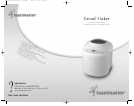
8.
Bread Maker Use and Care Guide
Helpful Hints for Bread and Dough
We recommend that you read the following information before you shop for your ingredients. Your
bread maker will bake up to a 1
1
⁄2 pound loaf of fresh bread containing 3-4 cups of flour. All
ingredients except liquids must be at room temperature and liquids should be approximately
80°F/27°C (baby bottle temperature). When preparing bread for the FAST BAKE
™
program, all liquid
temperatures must be 110°-115°F/43°-46°C. Always place the ingredients in the bread pan in the order
listed in the recipe: liquids, dry ingredients and then yeast. Some ingredient amounts are the same for
different size loaves.
MEASURING: THE CORRECT WAY
Be sure to measure accurately for success. Mis-measuring, even slightly, can make a big difference in
your results.
When you are measuring liquids, use a clear glass
or plastic liquid measuring cup. To ensure
accuracy, set the measuring cup on the counter
top and read the measurement at eye level.
To measure your flour, spoon it lightly into a
standard dry ingredient measuring cup and level
it with a straight edge. Also, do not shake the cup
or tap it on the counter top. Do not scoop the
flour with the measuring cup as this tends to pack
more flour than the recipes call for.
Use standard measuring spoons and level with a
straight edge.
1/4 CUP
1/2 CUP
1/4 tsp
1 TBL
1/2
tsp
1
tsp
1/3 CUP
1 CUP
MEASURING CUP
GRADUATED
MEASURING
CUPS
GRADUATED
MEASURING
SPOONS
Measurement/Conversion Chart
1 1/2 tsp = 1/2 TBL 8 TBL = 1/2 cup
3 tsp = 1 TBL 12 TBL = 3/4 cup
1/2 TBL = 1 1/2 tsp 16 TBL = 1 cup
2 TBL = 1/8 cup3/8 cup= 1/4 cup + 2 TBL
4 TBL = 1/4 cup5/8 cup= 1/2 cup + 2 TBL
5 TBL + 1 tsp = 1/3 cup7/8 cup= 3/4 cup + 2 TBL
DOUGH BALL: NECESSARY FOR A SUCCESSFUL LOAF OF BREAD
We have found that liquid amounts called for in a recipe may need to be adjusted slightly because
different climates and seasons result in a wide variety of humidity levels. You should check the dough
ball at the beep during the kneading process, see program specifications. At this point, the ball should
be round, smooth-textured, soft and slightly tacky to the touch. When touched it will leave a little
dough on your finger. Push down any dough or flour that may be on the sides of the pan. If it does
not form a ball and is more like a batter, add 1 tablespoon of bread flour at a time until it reaches the
appropriate consistency. On the other hand, if the moisture is too dry to form a ball, forms more than
one ball, or is a ball but not soft and slightly tacky, add 1 teaspoon of water and allow it to absorb. Add
more water if necessary. Provided you have used all of the ingredients specified in the recipe,
measured the ingredients properly, and have a “good” dough ball, you should achieve a successful loaf
of bread.
TBR15&CAN_IB_4-11-03(New) 11/4/03 3:45 PM Page 8


















